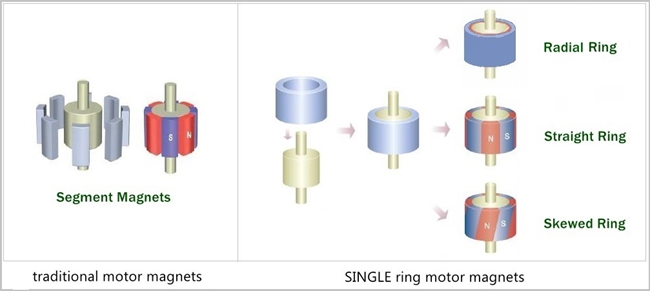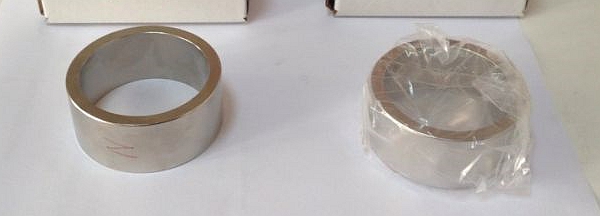|
Micro Motor Rotor of New Energy Automobile |
Electric motors are driven by powerful permanent magnets. The most applied ones are sintered neodymium magnets. Utilizing a SINGLE ring, at present, RADIAL & MULTI-POLE SINTERED ndfeb magnets are popular for micro motor instead of the traditional assemblied segment or arc magnets.
Radial or multi-pole sintered ndfeb ring magnets are a fairly mature product which can improve the motor output charateristics and reduce the loss of motor significantly. They are made by new technology – hot press. The hot press production process includes milling, hot-press and hot deformation. There is no need for molding & sintering of magnetic field orientation compared with normal sintered material. That's because its radial orientation is formed in the process of hot deformation of material and its inner structure is nano-sized crystal structure. They can be magnetized into multi-pole, skewed multi-pole and radial uni-pole (uni-pole magnet refers to the magnet only has one pair of north & south poles), as shown in picture below.
 |
What is radial ring magnet advantages?
1. Reducing much assembly cost
2. High-dimensional accuracy
3. Smaller air gap for motor to improve power density
4. Number of poles and skew angle to reduce the cogging torque
5. Magnetic flux waveforms can be controlled into sine from rectangular
6. Excellent temperature stability, corrosion resistance and temporal stability
7. Reducing motor noise
Four extra advantages of multi-pole sintered ndfeb ring magnet
8. sky-high flux density
9. realizing efficient utilization of permanent rare earth magnet
10. non-magnetic material rotor shaft can reduce the weight of motor without reducing magnet performance
11. making motor of a smaller and lighter design
Where and when can you use RADIAL & MULTI-POLE SINTERED NdFeB magnets?
Application: electric tools, synchronous motors, stepping motors, DC brushless motors, peripheral motors, spindle motors and steering control motors
Magnet size range: D16 x D12 x H H<15
D70 xd x H, the thickness of wall: 2-7mm, H<50
Magnet grade: N35-N42, N35H-N42H, N35SH-N42SH, N33UH-N35UH
Magnet angle of skew magnet: ≤45°, the smaller the angle, the easy the production; magnet with 45°direction is mainly used in drive system; whereas motors use magnet with angle about 10°
 |
Radail ring magnet will be the future development tendency of motor magnets. However, even with proven technique, it can’t replace traditional arc or bread motor magnet. Why is this happening?
1. Radial magnet is expensive because tooling charge and coil fee are required in most cases.
2. With outer diamter under 20mm, the bonded magnet shows more comprehensive advantage.
3. Due to size limitaton, some big diameter magnets only can be realized by segment magnets.
4. If the magnet has too many poles, radial ring is a good solution.
5. If magnet is four poles, It’s better to assemble arc magnets into ring.
Read More:
Arc Segments Permanent Magnets – the Most Popular High-Performance Motor Magnets Solutions
 China Magnets Source Material Limited
China Magnets Source Material Limited